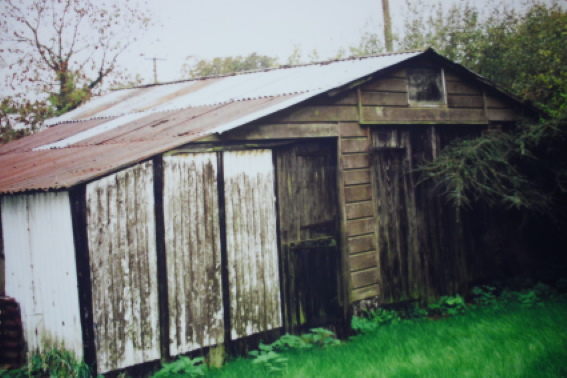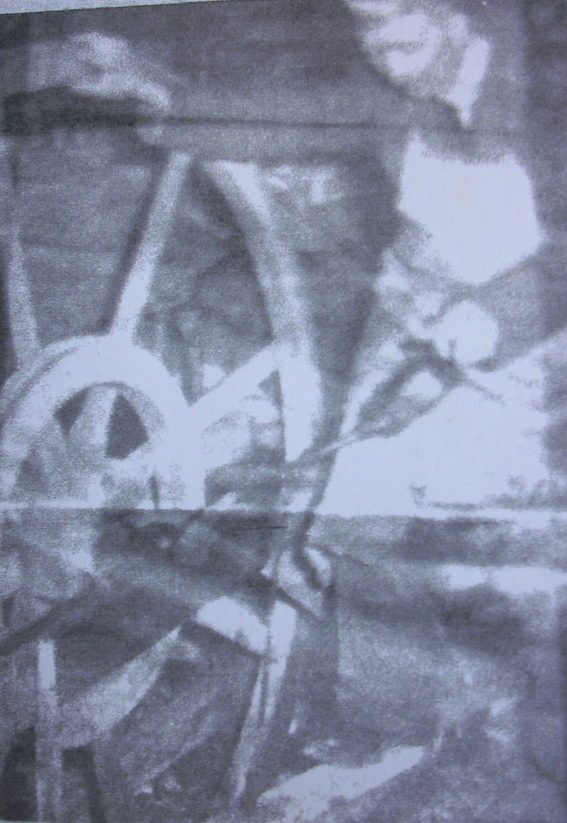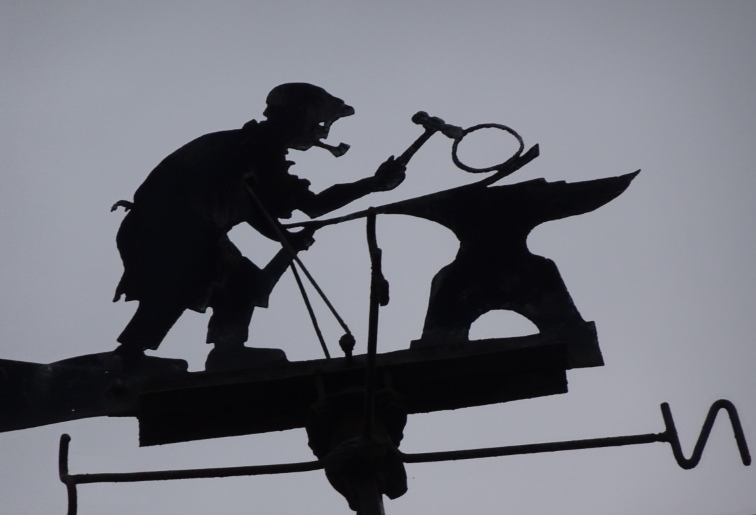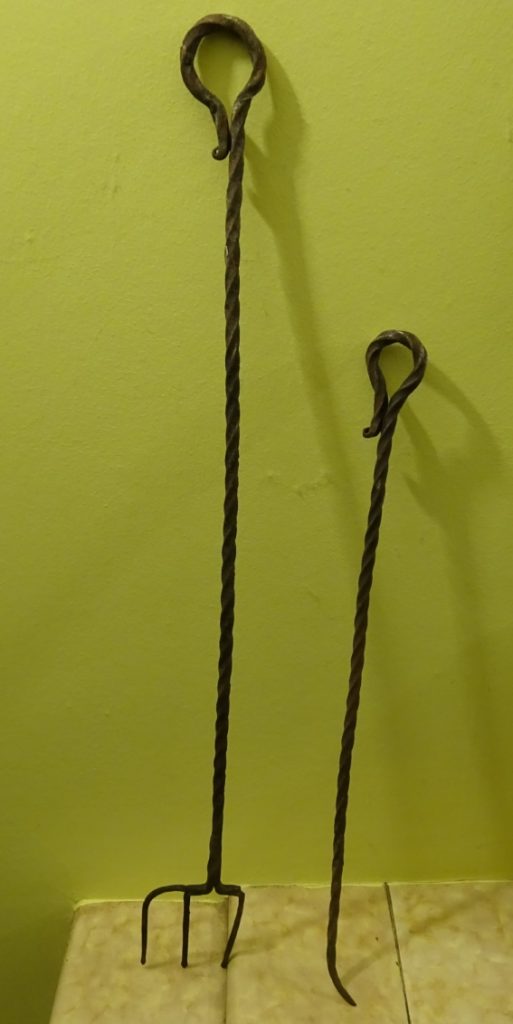Sue Fay spent her early life in the village of Great Ellingham and has connection to many Great Ellingham families, including her paternal line of Lebbell.
Long Street with Lebbell’s Smithy to the right
The Lebbell family had a smithy and shop in Long Street. Sue has a clear recollection of her family’s Smithy and shares the following memories:
The Blacksmith’s Shop in Long Street
The Blacksmith’s Shop was situated at the far south-west corner of the plot later known as Stonehenge.
Lebbell’s Smithy in Long Street. Courtesy of Susan Fay
It was built about 1800. It consisted of a single storey small bungalow constructed of clay lump walls, the first two and a half feet being tarred to repel the damp, with lime wash above and the roof brown tiles.
There was a small extension on the back to the east. The main chimney was on the north side.
There were several windows large and small, but with shutters instead of glass. However, the back extension had a large fixed glass window. The main entrance was from the west only three or four feet from Long Street, although there was a door at the north too.
The Surrounding Garden
Let’s look at the garden surround first.
On the ground to the south-east amid the grass is a large iron ring. It protrudes about four inches above ground, (one could easily trip over it in the grass). This is used by the smiths as a guide when putting an outside iron rim on a cartwheel – one of the most difficult and expensive jobs undertaken. Most of the blacksmiths were wheelwrights and carpenters too (this task demands at least two people).
Up by the north wall there are several six-foot iron rods, each about ½ inch thick. It is from these that the horseshoes are fashioned.
The western entrance is a stable door – but there is nothing on the outside by way of a sign. If the top door is open it reveals several horseshoes and a donkey shoe all nailed up pointing down, (what we would think of as the wrong way up).
A Tour of the Smithy & Shop
So come over the wooden four inch high ‘trostle’ (Norfolk dialect for threshold) with me, and we will have a look around. It is very dark inside, but there is a very feeble electric bulb and the light emitting from the rear window to help us.
The floor is grimy and made from beaten chalk. In the atmosphere, there is a general smell of sootiness and blackness. However, not a lot of cobwebs (good for those of us who fear spiders!).
Looking up are the rafters and undersides of the tiles – no felt.
The main building is divided into two sections, the west larger than the east and both are divided by the main chimney. On either side of this is a hearth at waist height.
Bellows
Attached to the chimney on each side are the bellow handles. They jut out at right angles at shoulder height, and each is tipped with a cow horn for a handle. They are fully functional.
My cousin and I agree that as children pumping those bellows up and down is fantastic fun. Having pumped for a few moments the chimney whirrs for a while, so we run from one handle to the other – the chimney roars.
Occasionally my father or my uncles undertake a little metal working job at the forge, then we pump the bellows for real in a stop/start movement, the coal fire is going and we must pump to change the flame from orange through yellow to white in order for the metal to melt and be shaped, then to the anvil per dum per dum per dum per dum, – one strike to the metal, one to the anvil.
With the fire going the temperature rises, the shutters are opened – no need for glass.
The Anvils
There is one anvil in front of each hearth, both are very heavy.
I digress, but up at the Spooner Row Smithy if you are a Journeyman Smith in want of a position, part of the interview is to carry the anvil a circuit of ‘the yard’ to prove strength and stamina for the job!
Benches, Vice and a multitude of Implements
Back in the shop all along the north wall under the main windows of each section are benches, each have a vice attached, above these suspended on nails many pairs of pliers sit, and below on the benches a multitude of muddled tools – pokers, tongs, chisels, planes, files, punches, spanners, hammers, hack saws and of course nails and screws, together with one or two small crucibles for lead working.
Cartwheel Pennies & Cauldrons
Also spilling over in a small leather box many defaced copper cartwheel pennies lie, all dated 1797. These are used to mend the copper kettles and pans which appear regularly for repair.
On the ground nearby are three iron cauldrons, large, medium and small.
Horse Shoes & Traps
On the walls opposite the chimney hang various horse shoes, farm and garden tools, together with a man-trap, a dog-trap, a rat-trap and mole traps.
12th century Chain-Mail
In front of these hanging up is a suit of chain-mail, a sort of long t-shirt shape with arms to the elbows. This has been dredged out of a stream on land belonging to a family member at the bottom of Long Street, in the first half of the 20th century. It is believed to be 12th century in date.
Farrier’s Teaching Aid
On a stool in front of the armour sits a whole carthorse hoof together with it’s pedal bone attached which you may find macabre. But which is, of course, a farrier’s teaching aid.
18th century Treadle Lathe
In the lean-to part at the far east sits a treadle lathe, (like a large spinning wheel) dating from the 18th century, for fine work. Good light is provided by the large window. The lathe was probably used for shaping wood or sharpening tools, always functional, it spins round fast on pumping the treadle – beware to keep fingers away from the wheel!
The above photograph shows William Robert Lebbell oiling this lathe in 1953. Courtesy of Susan Fay
So the tour is at an end and we are outside again.
Work of the Lebbell Family Blacksmiths
Let’s consider the family history and the work of these blacksmiths at the Smithy.
Lebbell Family
The oldest recorded family member in the village was Isaach Lebbell when he married Sarah Hardy in October 1758. It is not absolutely certain that he was a blacksmith, but his sons Isaac (who was based in Scoulton) and James definitely were. James worked at this Smithy.
In the early to mid 19th century, James’s son Robert also worked here, and another son, Edward, worked at Deopham. Both following in their father’s footsteps.
Robert combined the job with Innkeeping and his son, Robert Barnard Lebbell, combined it with farming. This was in the latter half of the 19th century.
Robert Barnard Lebbell’s two sons, Herbert Barnard Lebbell and William Robert Lebbell, carried on during ‘La Belle Epoch’ 1900-1914. William eventually closed the shop in 1917 and turned to dairy farming. His eldest son did try about three years of smithing apprenticeship in the early 1920s, but, unfortunately, to no avail.
Work of Robert Barnard Lebbell
The earliest records date from 1889 and documents the work of Robert Barnard Lebbell. However, only the work for the village farmers has survived.
In the month of June, Robert removed 15 shoes and put 71 new shoes on. Many shoes were cast in the fields and lanes, (there were no metalled roads in the village at that time).
In the same month he also repaired a Tumbril, mended a brace on a waggon, repaired a long ladder, made a new plough hammer, made a hedging iron, sharpened a crowbar, repaired four forks (haymaking month), and made two bolts and two springs amongst many other tasks.
Work of William Robert Lebbell
Weather vane depicting a self portrait of William Robert Lebbell at work. Made c1960. Photograph courtesy of Susan Fay
The records are more comprehensive for William Robert Lebbell, particularly for the years 1908-1911.
We know that in about February 1908, he made a complete waggon with a blacksmith from another village. Further, in 1909 he spent a whole day making a coffin with James Houchen – his brother’s father-in-law.
William was doing a lot of shoeing and agricultural equipment repair. Sometimes he would stop for a day to help with the harvest. For example, in August 1909, William was carting oats for his father, and in September gathering peas with his father-in-law.
Fire Poker and Toasting Fork (one prong now broken) made in 1854 by William Robert Lebbell as a wedding present. Photograph courtesy of Susan Fay
Repair Work
Some Interesting domestic repairs include:
Four kettles, one coal skuttle, watering can, lantern, carving and bread knife, window, a new hoop for a washing tub, mended an ear trumpet for Mr Toll, a bicycle for Miss Rivett, mended Mr Filby’s milk can, and Mr Bilverstone’s oven door, and repaired and cleaned a gun lock for Benjamin Partridge.
Outside Visits
William also did outside visits mainly to hang gates, he put on two new well-covers for farmer John Dixon. He went to Ellingham Hall a lot, working for Mr Cobon – another well top cover, and a new toilet seat ‘on the closet in the yard’ among other tasks.
Supply of Oil
In addition to this he was selling oil (for the lamps) on a regular basis. Someone called ‘Rachel’ bought this little and often, among many other customers. William had a busy life with five children to support!
Finally about the horseshoes (above).
Left – 18th century shoe from smithy – shoe is flat.
Centre 19th century shoe from smithy – shoe is denser.
Right – Late 20th century factory made shoe – note the ‘fuller’s grove’ – this uses less metal and lightens the shoe.
The last one comes from a 14 hand pony so we can deduce the left one is from a pony or possibly mule of about 13.2-14 hands and the middle one a carthorse of about 16 hands.
Demolishment in the 1980s

The intact Blacksmith shop was unfortunately demolished in the 1980s and everything of those working there and those lives lived are gone – only the records, the memories and the hoofprints remain!
Sue Fay, granddaughter of William Robert Lebbell. November 2021





